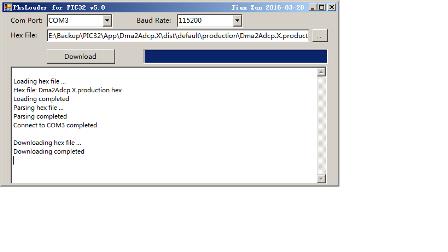单片机怎么通过串口把变量int i的值传送到pc端显示
Posted
tags:
篇首语:本文由小常识网(cha138.com)小编为大家整理,主要介绍了单片机怎么通过串口把变量int i的值传送到pc端显示相关的知识,希望对你有一定的参考价值。
参考技术A unsigned char ii;ii = i;//取i低8位
......//发送
i >>=8;
ii = i;//取i高8位
......//发送
PC端软件如果自己编写,可以轻松的显示i的值。如果用一些现成的串口小软件,那只能分成两个字节显示了。 参考技术B #include <AT89X51.h>
#define uchar unsigned char
#define uint unsigned int
main()
uchar i;
uint j;
SCON= 0x40; //串口方式1
PCON=0; //SMOD=0
REN=1; //允许接收
TMOD= 0x20; //定时器1定时方式2
TH1= 0xe6; //12MHz 1200波特率
TL1= 0xe6;
TR1= 1; //启动定时器
while(1)
i=0;
while(trdata[i]!=0x00)
SBUF=trdata[i];
while(TI==0);
TI=0;
i++;
for (j=0;j<50000;j++);
i=0;
while(trdata1[i]!=0x00)
SBUF=trdata1[i];
while(TI==0);
TI=0;
i++;
for (j=0;j<50000;j++);
本回答被提问者采纳 参考技术C 先把INT型数据拆开,高8位和低8位。
或先发i 的高8位,再发低8位,PC端收到后组合起来就可以了。
PIC32单片机端C语言serial bootloader和PC端C#语言bootloader串口通信程序
今天介绍下我新完成的为Microchip的32位单片机PIC32MZ2048ECH144开发的UART bootloader程序。整个工程分两部分,第一部分是单片机端用XC32编译的bootloader程序PhsBoot_v5.0,另一部分是PC端用C#编译的bootloader通讯程序PhsLoader_v5.0。两者之间采用固定的协定通信合作,如下。
<STX><CMD><ADDRL><ADDRH><ADDRU><ADDRM><LEN><DATA>...<DATA><ETX>
STX - Start of packet indicator
ETX - End of packet indicator
LEN - The length of true data
DATA - General data 16 bytes, only first LEN of datas are true
CMD - Base command
ADDR - Address up to 32 bits ( ADDRL , ADDRH , ADDRH, ADDRM)
具体有以下Base command:
RD-VER: 0x00 -- Read Version Information (最终版本未实现)
RD_MEM: 0x01 -- Read Program Memory (最终版本未实现)
ER_MEM: 0x03 -- Erase Program Memory
WR_MEM: 0x02 -- Write Program Memory
WR_CFG: 0x04 -- Write Configuration Registers (最终版本未实现)
PhsLoader_v5.0
PhsLoader_v5.0是PC端的程序,负责打开串口,加载应用程序hex文件,并按照上面介绍的协定进行组包然后发送出去。PhsLoader_v5.0是用C#开发的包含UI的程序,UI如下图。

PhsLoader_v5.0 的主要实现代码如下
private void btnLoad_Click(object sender, EventArgs e) { btnDownload.Enabled = false; textBoxStatus.AppendText("\r\nLoading hex file ...\r\n"); OpenFileDialog openDialog = new OpenFileDialog(); openDialog.Filter = "Hex files (*.hex)|*.hex"; if (openDialog.ShowDialog() == DialogResult.OK) { textBoxFile.Text = openDialog.FileName; string[] pathArray = textBoxFile.Text.Split(‘\\‘); int pathDeep = pathArray.Count(); textBoxStatus.AppendText("Hex file: " + pathArray[pathDeep - 1] + "\r\n"); textBoxStatus.AppendText("Loading completed\r\n"); HexParse loaderParse = new HexParse(); textBoxStatus.AppendText("Parsing hex file ...\r\n"); if (loaderParse.IsHexFile(textBoxFile.Text)) { btnDownload.Enabled = true; loaderLines = loaderParse.HexLines; textBoxStatus.AppendText("Parsing completed\r\n"); } else { textBoxStatus.ForeColor = Color.Red; textBoxStatus.AppendText("Parsing failed\r\n"); textBoxStatus.ForeColor = Color.Black; } } else { textBoxStatus.ForeColor = Color.Red; textBoxStatus.AppendText("Loading failed\r\n\r\n"); textBoxStatus.ForeColor = Color.Black; } } private void btnDownload_Click(object sender, EventArgs e) { btnDownload.Enabled = false; if (!this.connect()) { btnDownload.Enabled = true; return; } try { loaderReader = new StreamReader(textBoxFile.Text); } catch (Exception ex) { Debug.WriteLine("Error: " + ex.Message); textBoxStatus.ForeColor = Color.Red; textBoxStatus.AppendText("Read hex file unsuccessfully\r\n"); textBoxStatus.ForeColor = Color.Black; loaderReader.Close(); loaderSerial.Close(); btnDownload.Enabled = true; return; } loaderFrame = new SerialFrame(); if (!erase()) { textBoxStatus.ForeColor = Color.Red; textBoxStatus.AppendText("Erase unsuccessfully\r\n"); textBoxStatus.ForeColor = Color.Black; loaderReader.Close(); loaderSerial.Close(); btnDownload.Enabled = true; return; } pBarLoading.Refresh(); pBarLoading.Visible = true; pBarLoading.Value = 0; pBarLoading.Maximum = loaderLines; pBarLoading.Step = 1; string recordLine; loaderUpperAddr = 0; bool isNextLineUserID = false; bool isNextLineConfigBits = false; textBoxStatus.AppendText("\r\nDownloading hex file ...\r\n"); try { while (loaderReader.Peek() >= 0) { pBarLoading.PerformStep(); recordLine = loaderReader.ReadLine(); //if (recordLine.Contains(USER_ID_TOKEN) == true) //{ // isNextLineUserID = true; // continue; //} //else if (recordLine.Contains(CONFIG_BITS_TOKEN) == true) //{ // isNextLineConfigBits = true; // continue; //} if (recordLine.Contains(EXTEND_TOKEN) == true) { if (recordLine.Contains(USER_ID_TOKEN) == true) { isNextLineUserID = true; continue; } else if (recordLine.Contains(CONFIG_BITS_TOKEN) == true) { const int ADDR_U_START_INDEX = 9; const int ADDR_U_LENGTH = 4; string addrU = recordLine.Substring(ADDR_U_START_INDEX, ADDR_U_LENGTH); loaderUpperAddr = Convert.ToInt32(addrU, 16) << 16; isNextLineConfigBits = true; continue; } else if (recordLine.Contains(DSPIC_CONFIG_BITS_TOKEN) == true) { const int ADDR_U_START_INDEX = 9; const int ADDR_U_LENGTH = 4; string addrU = recordLine.Substring(ADDR_U_START_INDEX, ADDR_U_LENGTH); loaderUpperAddr = Convert.ToInt32(addrU, 16) << 16; isNextLineConfigBits = true; continue; } else if (recordLine.Contains(PIC32_CONFIG_BITS_TOKEN) == true) { const int ADDR_U_START_INDEX = 9; const int ADDR_U_LENGTH = 4; string addrU = recordLine.Substring(ADDR_U_START_INDEX, ADDR_U_LENGTH); loaderUpperAddr = Convert.ToInt32(addrU, 16) << 16; isNextLineConfigBits = true; continue; } else { const int ADDR_U_START_INDEX = 9; const int ADDR_U_LENGTH = 4; string addrU = recordLine.Substring(ADDR_U_START_INDEX, ADDR_U_LENGTH); loaderUpperAddr = Convert.ToInt32(addrU, 16) << 16; continue; } } else if (recordLine.Contains(END_OF_HEX_FILE_TOKEN) == true) { break; } if (isNextLineUserID) { isNextLineUserID = false; // do nothing; } else if (isNextLineConfigBits) { //if (!DownloadConfigLine(recordLine)) //{ // Debug.WriteLine("Error found during configuration bits programming"); // loaderReader.Close(); // loaderSerial.Close(); // btnDownload.Enabled = true; // return; //} DownloadConfigLine(recordLine); isNextLineConfigBits = false; } else { if (!DownloadDataLine(recordLine)) { Debug.WriteLine("Error found during data programming"); loaderReader.Close(); loaderSerial.Close(); btnDownload.Enabled = true; return; } //DownloadDataLine(recordLine); } } } catch (Exception ex) { Debug.WriteLine("Error: " + ex.Message); textBoxStatus.ForeColor = Color.Red; textBoxStatus.AppendText("Downloading failed\r\n"); textBoxStatus.ForeColor = Color.Black; loaderSerial.Close(); loaderReader.Close(); btnDownload.Enabled = true; return; } textBoxStatus.AppendText("Downloading completed\r\n"); if (!run()) { textBoxStatus.ForeColor = Color.Red; textBoxStatus.AppendText("Jump to Application unsuccessfully\r\n"); textBoxStatus.ForeColor = Color.Black; loaderReader.Close(); loaderSerial.Close(); btnDownload.Enabled = true; return; } loaderSerial.Close(); loaderReader.Close(); btnDownload.Enabled = true; }
PhsBoot_v5.0
PhsBoot_v5.0是PIC32单片机端程序,放置在程序存储器中,放置的位置和我上一款PIC32 bootloader(HyperBootloader_PIC32)一样。所以他们的linker script也使用一样的。PhsBoot_v5.0主要功能是接收PhsLoader_v5.0发送过来的数据包,按照通信协定进行解包,分离出其中的地址和数据,并将数据按照PIC32的烧写时序烧录到对应的地址中。PhsBoot_v5.0 是用XC32开发的,主要的实现代码如下。
if (lineReceived) { if ((frameBuffer[0] == STX) && (frameBuffer[BUFFER_MAX-1] == ETX)) { switch (frameBuffer[CMD_INDEX]) { case WR_MEM: SourceAddr.byte.LB = frameBuffer[ADDRL_INDEX]; SourceAddr.byte.HB = frameBuffer[ADDRH_INDEX]; SourceAddr.byte.UB = frameBuffer[ADDRU_INDEX]; SourceAddr.byte.MB = frameBuffer[ADDRM_INDEX]; if ((SourceAddr.word.HW == 0x1fc0)) { SendResponse(); break; } int ix; for (ix=0;ix<frameBuffer[LEN_INDEX];) { pData.byte.LB = frameBuffer[LEN_INDEX+1+ix++]; pData.byte.HB = frameBuffer[LEN_INDEX+1+ix++]; pData.byte.UB = frameBuffer[LEN_INDEX+1+ix++]; pData.byte.MB = frameBuffer[LEN_INDEX+1+ix++]; NVMWriteWord(SourceAddr.Val, pData.Val); SourceAddr.Val += 4; } //Uart_Putc(0x55); //for debug SendResponse(); break; case WR_CFG: //WriteWordMem(CM_WORD_WRITE); //Uart_Putc(0x00); // for debug SendResponse(); break; case ER_MEM: //EraseMem(); for (EraseAddr.Val = ERASE_FLASH_BASE_ADDRESS; EraseAddr.Val < ERASE_FLASH_END_ADDRESS;) { NVMErasePage(EraseAddr.Val); EraseAddr.Val += PAGE_SIZE; } //Uart_Putc(0xaa); // for debug SendResponse(); break; case RUN_APP: //Uart_Putc(0xff); // for debug SendResponse(); TRISCSET = 0x2000; // RC13 Input LATCCLR = 0x6000; // Clear LATC IPC28CLR = 0x1F00; // Clear IPC28 LATHCLR = (1<<0); TRISHSET = (1<<0); CoreT_DelayMs(10); U1MODE = 0x0; U1STA = 0x0; (*((void(*)(void))USER_APP_RESET_ADDRESS))(); default: break; } } lineReceived = 0; lineBytes = 0; readBytes = 0; }
如何使用PhsLoader_v5.0和PhsBoot_v5.0
1. 使用XC32编译PhsBoot_v5.0(编译前,需先修改linker script)。
2. 使用pickit3烧录PhsBoot_v5.0的Hex文件到目标板中。
3. 拔除pickit3烧录器
4. 连接目标板与PC的串口,打开PhsLoader_v5.0,选择COM端口,BAUD RATE。
5. 点击PhsLoader_v5.0用户界面上的“.."按钮加载需要烧录的应用程序Hex文件(编译前,需先修改linker script)
6. 重启目标板,等到LED1 灯亮了,立刻在PhsLoader_v4.0界面上点击Download按钮。如果超时未点击Download按钮,会自动跳转到上次烧录的应用程序中去。
7. 烧录完毕,再次重启目标板, 6秒后目标板开始正常运行应用程序。
之后每次更新应用程序,只需重复步骤 4 ~ 7 就可以了。注意,整个烧录过程未能实现Configuration Bits的烧写,所以需要保持应用程序的Configuration Bits和Bootloader的Configuration Bits一致。
以上是关于单片机怎么通过串口把变量int i的值传送到pc端显示的主要内容,如果未能解决你的问题,请参考以下文章